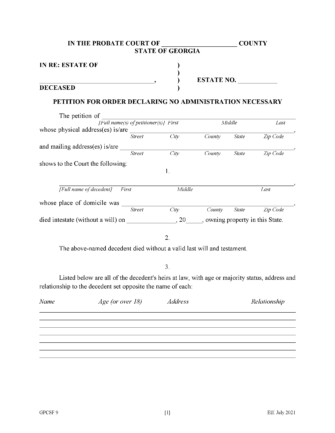Laws
- Maximum Estate Value: Not mentioned in state statutes.
- Mandatory Waiting Period: Not mentioned in state statutes.
- Where to File: Probate Court
How to File (4 Steps)
Step 1 – Estate Requirements
Georgia does not technically use small estate affidavits. Instead, it offers a simplified probate process known as No Administration Necessary, which is only available when the following requirements are met[1]:
- The decedent died intestate (without a will)
- No personal representative has been appointed
- The petitioner is an heir of the estate
- All heirs consent to the proposed distribution of the estate
- All known creditors have been paid in full or consent to the planned distribution
Step 2 – Complete Petition
The petitioner must complete the Petition for Order Declaring No Administration Necessary. All known heirs and creditors are required to provide their notarized signatures on the Petition to indicate their consent to the proposed distribution.
Step 3 – File Forms with Probate Court
After preparing the paperwork, the petitioner must submit their filings to the probate court in the county where the decedent resided at the time of death. A copy of the death certificate and payment for the filing fee will also be required (fees vary by county).
If any heir or creditor has not consented, the court may order that they be formally served with notice of the filing.
Step 4 – Distribute Assets
If the Petition is approved, the judge will issue an order allowing the estate to be settled without formal probate administration. The petitioner may then use the court order to collect the decedent’s property and distribute the assets in accordance with the approved plan.

